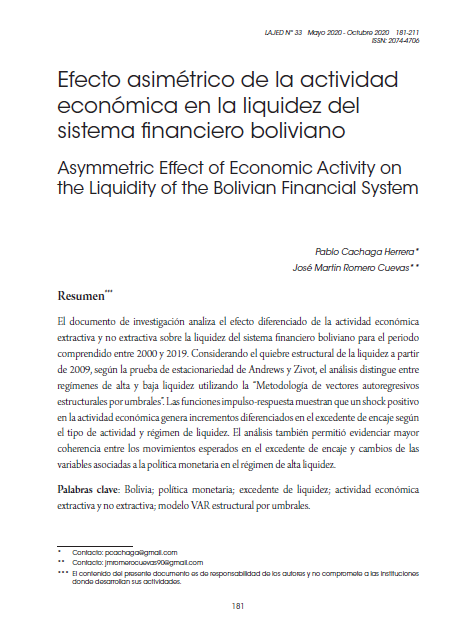Asymmetric Effect of Economic Activity on the Liquidity of the Bolivian Financial System
DOI:
https://doi.org/10.35319/lajed.202033420Keywords:
Bolivia, monetary policy, liquidity surplus, extractive and non-extractive economic activity, Structural ftreshold Vector Autoregression ModelAbstract
The research document analyzes the differentiated effect of extractive and non-extractive economic activity on the liquidity of the Bolivian financial system from 2000 to 2019. Considering the structural breakdown of liquidity from 2009 according to the Andrews and Zivot stationarity test, the analysis distinguishes between high and low liquidity regimes using the Structural ftreshold Vector Autoregression methodology (TVAR). The impulse- response functions show that a positive shock in economic activity generates differentiated increases in liquidity surplus according to the type of activity and liquidity regime. The analysis also revealed greater coherence between the expected movements in the liquidity surplus and changes in the variables associated with monetary policy in the highly liquid regime.
Downloads
References
Agénor, P; Aizenman, J. y Hoffmaister A. (2004). fte Credit Crunch in East Asia: What can Bank Excess Liquid Assets Tell us? Journal of International Money and Finance, 23(1), 27-49.
Anderson R. (2011). Excess reserves in Jamaican Commercial Banks: The implications for Monetary Policy. MPRA Paper Nº 43663.
Balke, N. (2000). Credit and Economic Activity: Credit Regimes and Nonlinear Propagation of Shocks. The Review of Economics and Statistics, 82(2), 344-349.
Balke, N. y Chang, P. (1995). Credit and Economic Activity: Shocks or Propagation Mechanism. Working Papers 9519, Federal Reserve Bank of Dallas.
Banco Central de Bolivia (2009). Informe de política monetaria, julio de 2009.
Bolivia (2009). Constitución Política del Estado, 7 de febrero de 2009. Gaceta Oficial de Bolivia.
Cernadas, L. (2013). Determinantes del exceso de liquidez: evidencia empírica para Bolivia. Revista de Análisis del Banco Central de Bolivia, 19(1), 57-102.
Deléchat C.; Henao, C.; Muthoora, P. y Vtyurina, S. (2012). The Determinants of Banks’ Liquidity Buffers in Central America. Working Paper 12/301, International Monetary Fund.
Diamond D. y Dybvig, P. H. (1983). Bank runs, deposit insurance and liquidity. The Journal of Political Economy, 91(3), 401-419.
Diamond, D. y Rajan, R. (2001). Liquidity risk, liquidity creation and financial fragility: A theory of banking. The Journal of Political Economy, 109(2), 287-327.
---------- (2005). Liquidity Shortages and Banking Crises. Journal of Finance, 60(2), 615-647.
Gerlach, S y Smets, F. (1995). The Monetary Transmission Mechanism: Evidence From the G-7 Countries. BIS Working Papers 26, Bank for International Settlements.
Godfrey F. N; Akume D. y Nkwetta A. A. (2017). Modelling the Impact of Liquidity Trend on the Financial Performance of Commercial Banks and Economic Growth in Cameroon. International Journal of Financial Research, 8(3), 121-134.
Gray, S. (2011). Central Bank Balances and Reserve Requirements. Working Paper 11/36, International Monetary Fund.
Karkowska R. (2015). Global Liquidity Determinants Across Emerging and Advanced Countries. Journal of Banking and Financial Economics, 1(3), 152-170.
Orellana, W.; Lora, O.; Mendoza, R. y Boyan, R. (2000). La política monetaria en Bolivia y sus mecanismos de transmisión. Revista de Análisis del Banco Central de Bolivia, 3(1), 81- 123.
Popescu, I. (2012). Effects of monetary policy in Romania. A VAR approach. CES Working Papers. Centre for European Studies, Alexandru Ioan Cuza University, 4(3a), 605-624.
Saxegaard, M. (2006). Excess Liquidity and Effectiveness of Monetary Policy: Evidence from Sub-Saharan Africa. Working Paper 06/115, International Monetary Fund.
Todd, W. F. (2013). The Problem of Excess Reserves, Then and Now. Working Paper 763, Levy Economics Institute of Bard College.
Vodová, P. (2011). Determinants of Commercial Bank’s Liquidity in Slovakia. Paper prepared for Czech Science Foundation (Project GACR P403/11/P243). Recuperado de: http://www.opf.slu.cz/kfi/icfb/proc2011/pdf/65_Vodova.pdf.






